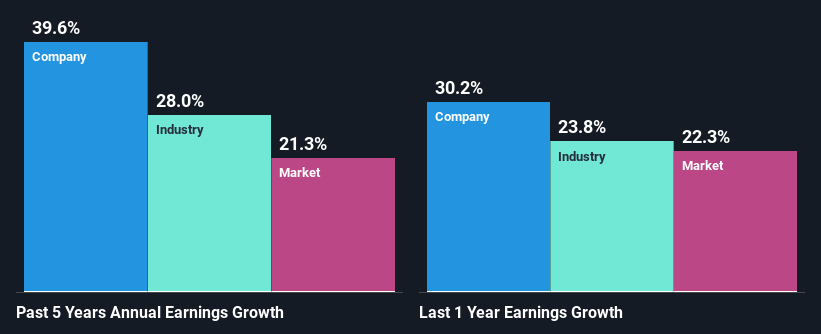Stock Analysis
- India
- /
- Metals and Mining
- /
- NSEI:JINDALSTEL
Do Its Financials Have Any Role To Play In Driving Jindal Steel & Power Limited's (NSE:JINDALSTEL) Stock Up Recently?

Jindal Steel & Power's (NSE:JINDALSTEL) stock is up by a considerable 27% over the past three months. We wonder if and what role the company's financials play in that price change as a company's long-term fundamentals usually dictate market outcomes. Specifically, we decided to study Jindal Steel & Power's ROE in this article.
ROE or return on equity is a useful tool to assess how effectively a company can generate returns on the investment it received from its shareholders. In other words, it is a profitability ratio which measures the rate of return on the capital provided by the company's shareholders.
Check out our latest analysis for Jindal Steel & Power
How Is ROE Calculated?
The formula for return on equity is:
Return on Equity = Net Profit (from continuing operations) ÷ Shareholders' Equity
So, based on the above formula, the ROE for Jindal Steel & Power is:
13% = ₹55b ÷ ₹418b (Based on the trailing twelve months to December 2023).
The 'return' is the income the business earned over the last year. One way to conceptualize this is that for each ₹1 of shareholders' capital it has, the company made ₹0.13 in profit.
Why Is ROE Important For Earnings Growth?
Thus far, we have learned that ROE measures how efficiently a company is generating its profits. We now need to evaluate how much profit the company reinvests or "retains" for future growth which then gives us an idea about the growth potential of the company. Assuming everything else remains unchanged, the higher the ROE and profit retention, the higher the growth rate of a company compared to companies that don't necessarily bear these characteristics.
A Side By Side comparison of Jindal Steel & Power's Earnings Growth And 13% ROE
At first glance, Jindal Steel & Power's ROE doesn't look very promising. However, its ROE is similar to the industry average of 13%, so we won't completely dismiss the company. Looking at Jindal Steel & Power's exceptional 40% five-year net income growth in particular, we are definitely impressed. Considering the moderately low ROE, it is quite possible that there might be some other aspects that are positively influencing the company's earnings growth. Such as - high earnings retention or an efficient management in place.
As a next step, we compared Jindal Steel & Power's net income growth with the industry, and pleasingly, we found that the growth seen by the company is higher than the average industry growth of 28%.

Earnings growth is an important metric to consider when valuing a stock. The investor should try to establish if the expected growth or decline in earnings, whichever the case may be, is priced in. This then helps them determine if the stock is placed for a bright or bleak future. One good indicator of expected earnings growth is the P/E ratio which determines the price the market is willing to pay for a stock based on its earnings prospects. So, you may want to check if Jindal Steel & Power is trading on a high P/E or a low P/E, relative to its industry.
Is Jindal Steel & Power Efficiently Re-investing Its Profits?
Jindal Steel & Power's three-year median payout ratio to shareholders is 4.8%, which is quite low. This implies that the company is retaining 95% of its profits. So it seems like the management is reinvesting profits heavily to grow its business and this reflects in its earnings growth number.
Besides, Jindal Steel & Power has been paying dividends for at least ten years or more. This shows that the company is committed to sharing profits with its shareholders. Our latest analyst data shows that the future payout ratio of the company over the next three years is expected to be approximately 4.9%. Accordingly, forecasts suggest that Jindal Steel & Power's future ROE will be 15% which is again, similar to the current ROE.
Summary
In total, it does look like Jindal Steel & Power has some positive aspects to its business. Despite its low rate of return, the fact that the company reinvests a very high portion of its profits into its business, no doubt contributed to its high earnings growth. With that said, the latest industry analyst forecasts reveal that the company's earnings growth is expected to slow down. Are these analysts expectations based on the broad expectations for the industry, or on the company's fundamentals? Click here to be taken to our analyst's forecasts page for the company.
Valuation is complex, but we're helping make it simple.
Find out whether Jindal Steel & Power is potentially over or undervalued by checking out our comprehensive analysis, which includes fair value estimates, risks and warnings, dividends, insider transactions and financial health.
View the Free AnalysisHave feedback on this article? Concerned about the content? Get in touch with us directly. Alternatively, email editorial-team (at) simplywallst.com.
This article by Simply Wall St is general in nature. We provide commentary based on historical data and analyst forecasts only using an unbiased methodology and our articles are not intended to be financial advice. It does not constitute a recommendation to buy or sell any stock, and does not take account of your objectives, or your financial situation. We aim to bring you long-term focused analysis driven by fundamental data. Note that our analysis may not factor in the latest price-sensitive company announcements or qualitative material. Simply Wall St has no position in any stocks mentioned.
About NSEI:JINDALSTEL
Jindal Steel & Power
Jindal Steel & Power Limited operates in the steel, mining, and infrastructure sectors in India and internationally.
Excellent balance sheet with reasonable growth potential.

